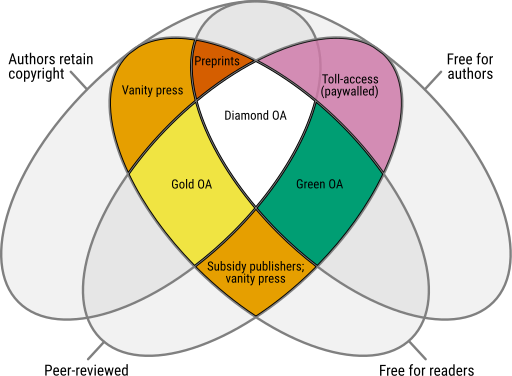The post below was originally published by Brandon Butler in 2023 and has been updated for Open Access Week by Scholarly Repository Librarian Sherry Lake.
The 2024 Open Access theme of Community over Commercialization continues last year’s theme prioritizing approaches to open scholarship that serve the best interests of the public and the academic community.
As a community, the open access movement is working to identify and grow alternatives to commercial oligopoly in the open access publishing ecosystem. These alternatives can support peer review and the other benefits of traditional publishing without the myriad dysfunctions that have grown up around it over the last century. The Library’s open publishing imprint, Aperio, is an excellent example of the cutting edge in open access publishing, and hopefully a glimpse of its future.
Open access (making one’s work freely available under an open license) per se is free to most academic authors, including all UVA authors, thanks to copyright law and free open repositories. What you’re really paying for in those scenarios where a publisher charges you an ‘open access fee’ is a combination of the prestige associated with a particular journal title and the cost of operating that journal. With respect to commercial publishers, that cost includes elements that most authors would not likely support if they had a choice, like huge executive salaries and 30%+ profit margins. Unfortunately, authors often feel they don’t have a choice, due to the impact of journal placement on their career prospects. Reforming promotion and tenure to decouple advancement from journal placement would be a major step in the right direction. But it’s also important to develop publication models that provide the services authors and readers value without exploiting either group in the way that commercial publishers too often do. What does that look like?
One example of an alternative that is free to both readers and authors is the “Diamond OA” model, where neither readers nor authors pay for publishing. To understand Diamond OA, it helps to understand a couple of the other color-codes used as a shorthand for different approaches to open access publishing.
- “Green OA” generally describes open access based on depositing your scholarship in an open repository like UVA’s Libra. Green OA can (and usually does) exist in parallel with publishing in a subscription/toll access journal; the author places their “post-print” in a repository, while the so-called “version of record” (with the publisher’s typesetting, pagination, etc.) is only available through a subscription.
- “Gold OA” describes open access where the publisher makes the final version freely available under an open license. While most Gold OA journals do not charge a fee to authors or their institutions, the most widely known Gold journals (and all commercially published ones) do, so Gold OA has become associated with this author-pays model.
- In recent years, Diamond OA has been the term used to describe the variety of approaches designed to remove price barriers for readers and authors alike. In a Diamond OA model, publishing infrastructure is operated (and funded) by universities, scholarly societies, or research funders.

In the past, the value proposition of academic publishing has been seen through a simple two-sided paradigm that looked to either readers or authors (or their institutions on their behalf) as the sources of financial support for a journal. Readers would be willing to pay for access to knowledge in their field, or else authors would be willing to pay for access to venues where their work will be seen and valued in their field.
For Diamond OA, the value proposition is more collective. The entity paying the cost of publication (and often hosting the journal) isn’t paying to read or publish any particular article; they are paying to support a community service that benefits the institution, the scholarly society, or the public. Diamond OA sponsors have a wide variety of reasons to do this, not least among them a desire to counteract the known downsides of the alternatives for researchers and their institutions.
Diamond OA at UVA
Our own Aperio Press is an example of a Diamond OA publisher. The UVA Library funds and operates Aperio, including the cost of publishing Aperio journals, as part of its commitment to sustainable scholarship. The Library is well-positioned to shop for publishing services, and the market for these services is much more transparent and competitive than the markets for journal subscriptions or article processing charges. For the cost of a couple of Nature article processing charges (literally two), we can publish dozens of articles per year in journals founded and operated by UVA scholars and make them available for free to the world. And because all Aperio journals must have a relationship to the University, supporting Aperio means supporting UVA scholars and scholarship. Establishing, managing, and editing a journal is important scholarly work, after all, and it is a wise investment to support that work directly. When you consider that the alternative is sending UVA editors out to find support from commercial actors who will turn around and erect price barriers against UVA readers, authors, or both, operating our own press becomes an even more obvious choice. Expanding this model throughout the scholarly ecosystem would free billions of dollars currently funneled to publisher oligopolies’ bottom lines to support actual research.
Aperio welcomes proposals from UVA faculty, staff, and students wishing to start new OA journals or transfer existing journals. The latter may include flipping a journal to open. More details about Aperio service offerings and applications are available at https://aperio.press/about. Proposals are accepted on a rolling basis and reviewed by Aperio’s Faculty Advisory Board on a quarterly basis. Consultations with Aperio’s Managing Editor (publish@virginia.edu) are highly recommended.
